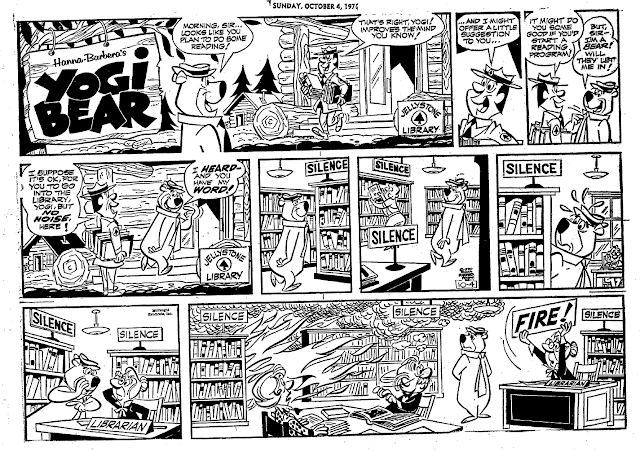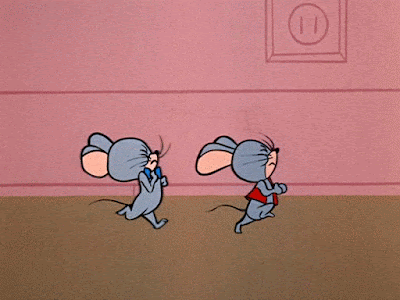Here’s today’s early Hanna-Barbera quiz—in which state was Huckleberry Hound the most popular? Perhaps it’s impossible to answer that question, but you probably couldn’t go wrong if you guessed Hawaii. It was the scene of a huge mob of fans not long as it became the 50th state.
The Huckleberry Hound Show made its first appearance in Hawaii’s territorial days on Thursday, October 2, 1958 on KULA-TV. The show, as we all know, appealed to adults as well as kids, and by 1959, the Isle Huckleberry Hound club numbering about 100 would gather in M’s Cheerio Room (a cocktail bar) every week to tune in the show. Someone at Hanna-Barbera took notice. The Honolulu Star-Bulletin reported on January 24, 1960 that Howard Pecquet, the club president, accepted a painting and ceramic statues of the show’s characters from someone representing Hanna-Barbera.
Pandemonium struck later that year. Screen Gems had a promotional department led by Ed Justin that not only came up with the idea of having people dress up as Huck, Yogi Bear, etc. for plugging purposes, he decided to launch a mock Huck-for-President campaign. One of the campaign stops—Honolulu. A bunch of tie-ins were worked out for Huck and his coterie—with Bill Hanna tagging along—to make a few days of appearances at the GEM store. An ad in the Star-Bulletin told kids that 800 free Huck T-Shirts would be given away at the Honolulu Airport a half-hour before a meet-and-greet with the newly-arrived gang.
800.
Guess how many people showed up?
The Star-Advertiser’s reporter made a guess after getting caught in the crowd. Here’s the paper’s story of July 23, 1960.
Justin told Broadcasting magazine that a throng of 25,000 swarmed on GEM to meet Huck and the department store was forced to lock its doors.
Huck got a chance to appear on the big screen during his trip. GEM sponsored a screening of Huckleberry Hound cartoons—in colour—at the Waialae Drive-In Theatre three days after the arrival, with the costumed Huck making another public appearance.
There’s a post-script to Huck’s appearance. A reference was made to it in the Star-Bulletin of March 26, 1961:
The Huckleberry Hound Show made its first appearance in Hawaii’s territorial days on Thursday, October 2, 1958 on KULA-TV. The show, as we all know, appealed to adults as well as kids, and by 1959, the Isle Huckleberry Hound club numbering about 100 would gather in M’s Cheerio Room (a cocktail bar) every week to tune in the show. Someone at Hanna-Barbera took notice. The Honolulu Star-Bulletin reported on January 24, 1960 that Howard Pecquet, the club president, accepted a painting and ceramic statues of the show’s characters from someone representing Hanna-Barbera.
Pandemonium struck later that year. Screen Gems had a promotional department led by Ed Justin that not only came up with the idea of having people dress up as Huck, Yogi Bear, etc. for plugging purposes, he decided to launch a mock Huck-for-President campaign. One of the campaign stops—Honolulu. A bunch of tie-ins were worked out for Huck and his coterie—with Bill Hanna tagging along—to make a few days of appearances at the GEM store. An ad in the Star-Bulletin told kids that 800 free Huck T-Shirts would be given away at the Honolulu Airport a half-hour before a meet-and-greet with the newly-arrived gang.
800.
Guess how many people showed up?
The Star-Advertiser’s reporter made a guess after getting caught in the crowd. Here’s the paper’s story of July 23, 1960.
10,000 at Airport See Huckleberry Hound, PalsActually, it was advertised that Joe Barbera that he was going to be there. Either the reporter didn’t spot him, or maybe Joe was busy checking out the hula dancers.
By ALTON SLAGLE
Honest, Huck, I was there. It's just that you didn't see me in the mob.
Some folks say there were 10,000 people at Honolulu Airport when your Pan American "Huckle-jet" landed yesterday afternoon. It would seem so, for the traffic was backed up bumper to bumper about two miles from the airport parking lot just before you Landed. Parking attendants said they handled about 1,000 cars while you were there and that doesn't count the hundreds parked outside the lot.
Huck, that's more people than President Eisenhower had at the airport to greet him last month. Airport police told me you also attracted more people than the Shah of Iran, the President of Indonesia, the Kings and Queens of Thailand and Nepal and the Crown Prince and Princess of Japan. Or even Jack Benny.
Did you see all the kids holding "Huck for President" signs? And the "Huckelberry [sic] Hound for President" badges on the coats of greeters like Lieutenant Governor James Kealoha and Mayor Neal S. Blaisdell?
Was that really Yogi Bear and Quick Draw McGraw following you down the plane's ramp? I laughed when the wind nearly blew McGraw's big head off. It looked almost like it was made of paper mache and cloth. I thought about all those rumors that local people had gone aboard the plane and donned costumes. But I knew better.
While you were busy with that big troupe of little hula and knife dancers, I chatted with one of your creators, William Hanna. He told me he had dreamed you up about three years ago and first put you in television cartoons last year. "I had no conception it would ever be this big," he said. "I'm delighted, of course. Now they have Huck watches and tee-shirts and . . . everything."
Say, Huck, how come Joseph Barbera, Hanna's partner didn't make the trip? Did those two really once draw the "Tom and Jerry" cartoons? And are you really going to Alaska next?
NOT MUCH SENSE
You know, Huck, some of those kids who met you did not use much sense. They crawled all over everything. And some of them even ran way out across those busy runways. Airport manager Gilbert Livingston said he had to send a radio car to clear them so planes could land.
But I hope you enjoyed the reception, Huck. It's just about the biggest in airport history. And I'll be looking forward to your three days of personal appearances at GEM.
By the way, Huck, I'm sorry traffic was so heavy that you and the Mayor and the Lieutenant Governor could not leave the airport for so long. Honest, Huck the terminal building had wall-to-wall children.
Justin told Broadcasting magazine that a throng of 25,000 swarmed on GEM to meet Huck and the department store was forced to lock its doors.
Huck got a chance to appear on the big screen during his trip. GEM sponsored a screening of Huckleberry Hound cartoons—in colour—at the Waialae Drive-In Theatre three days after the arrival, with the costumed Huck making another public appearance.
There’s a post-script to Huck’s appearance. A reference was made to it in the Star-Bulletin of March 26, 1961:
More than 3,000 screaming fans gave Elvis Presley a tumultuous welcome yesterday as the guitar-strumming singer stepped off a Pan American Airways plane at Honolulu Airport at 12:15 p.m. But the welcome did not equal in size or chaos the hullabaloo caused by the arrival here last year of Huckleberry Hound.Huck never broadcast a concert by satellite from Hawaii, but one of his cartoons in the second season was set there. “Wiki Waki Huck” would have aired on channel 4 in Honolulu on February 18, 1960. We wonder if the Cheerio Room was overflowing that night.






















































































